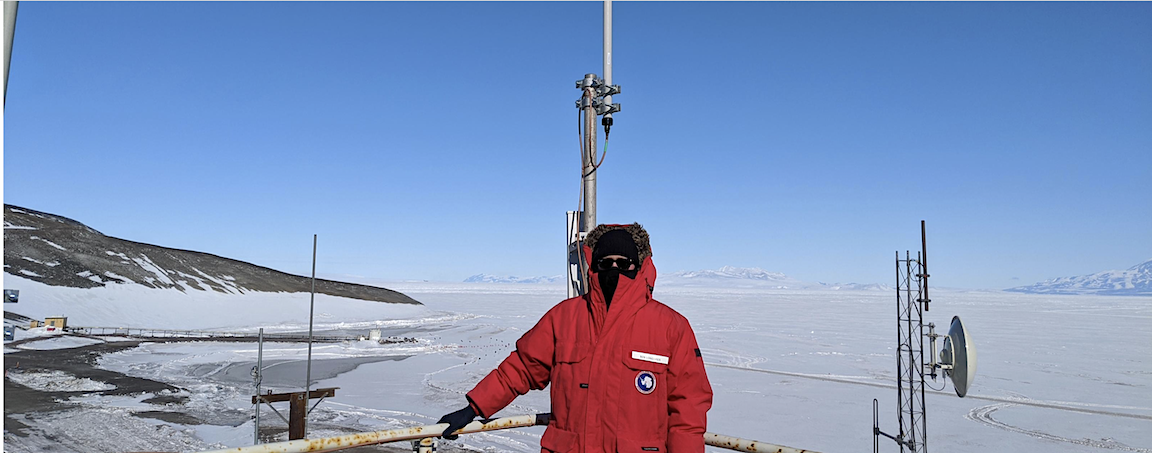
It’s all business for corporate founders: Meeting investors, interviewing potential hires, and—making an expedition to ride bikes in Antarctica?
That’s the case for Swarm Technologies, a San Francisco satellite start-up whose two founders journeyed over three days to remote McMurdo Station in November to install a ground antenna for a space network designed for Internet of Things sensors. The research center, on an island just 850 miles (1,360 km) from the South Pole, is operated by the National Science Foundation (NSF), which has also backed Swarm since 2016.
Swarm’s goal is to drive down the cost of small-scale communication from space by an order of magnitude or more, says Dr. Richard Schwerdtfeger, the NSF program manager who has approved $1.46 million in funding to the company through a program that backs innovative research at small businesses. Swarm has also received development grants from the U.S. Air Force and raised more than $25 million from private investors in a 2019 round led by Craft ventures.

Swarm CTO Benjamin Longmier with the antennae his company installed at McMurdo Station, Antarctica. Courtesy of Swarm
The company gained notoriety in 2018 for launching their prototype satellites without U.S. government permission, and later paying a $900,000 settlement to the FCC.
A visit to the icy station checked a number of boxes for Swarm’s founders, CEO Sara Spangelo and CTO Ben Longmier, who both boast advanced engineering degrees and have bounced between academia and high-tech business.
One challenge when operating a space communications network is getting the data down to the ground, especially at lower orbits where satellites are passing quickly around the planet. That means companies typically need to set up or purchase access to multiple ground stations; Swarm now operates five and plans to open nine more in 2020. One way to fill in the gaps is to put a relay at the poles, but there is little infrastructure to do so—which is why it can be helpful to have access to a scientific research station like McMurdo.
The hardware for the antennae must be robust: They will face temperatures ranging down to -60°C (-76°F) and winds gusting at speeds of 200 mph. Part of the experiment here is making sure their products can survive in harsh environments, since Swarm’s business plan is all about linking sensors—perhaps at a water pump in sub-Saharan Africa, a remote mine in Canada or a farm in rural Nebraska—that are far from traditional internet connections.
For now, the research team at McMurdo relies on satellite networks built by the private firm Iridium and NASA for most of its communication with the outside world, but these connections remain expensive. At a peak population of about 1,000 people during the summer months, the base has just 17 Mbps of connectivity—roughly the same as a single mobile phone connection, according to Longmier.
The Swarm team hopes that their network will eventually be able to pick up some of the slack for the scientists relaying the results of experiments back to home and help solve problems like four-hour communications blackouts between McMurdo and the research station maintained by the U.S. at the South Pole itself. At the very least, another dedicated ground station will help tune and track the 150 satellites the company plans to launch in the next year.
And then there’s the personal reasons: Both Spangelo, who was a finalist to become a Canadian astronaut, and Longmier are enthusiasts of the science that takes place in extreme environments, and jumped at the chance to make the journey across the world and undergo the necessary cold-weather survival training.
After working through the installation and debugging of the antennae, it was time for Spangelo and Longmier to test it. Carrying a prototype of a satellite “tracker” modem, they donned puffy red goose down jackets and inflatable boots to ride ice bikes across the Ross Ice Shelf. Sure enough, the tracker produced a record of their journey that they were able to view back at the station—and inspiration for a space-focused entrepreneur.
“It felt like we were on the surface of the Moon or Mars,” Longmier says. “In fact, a good number of the NASA psychological studies of isolated small groups come from various “winter-over” periods at McMurdo and South Pole bases. … Perhaps one day, we will even launch some of our satellites to lunar orbit and bring communications to an astronaut working in a nearby crater at ‘New McMurdo Station’ on the Moon.”
Correction: This post originally misreported the US military service that gave research grants to Swarm; it is the US Air Force. The post also reported that both founders have doctorates in aerospace engineering; Dr. Longmier’s Ph.d. is in plasma physics.
By Tim Fernholz, QZ

